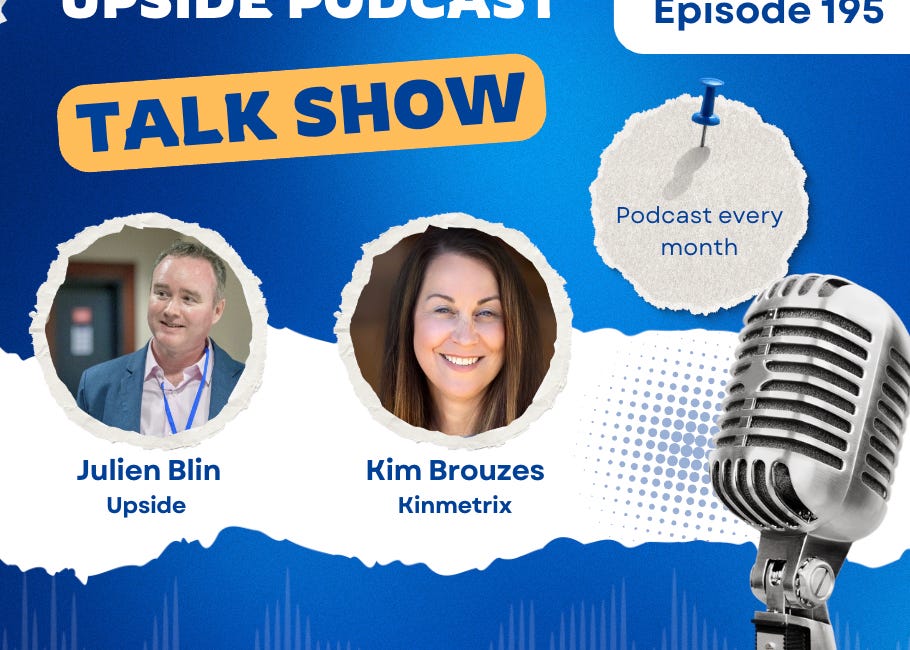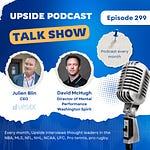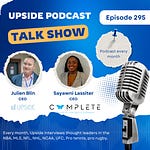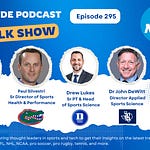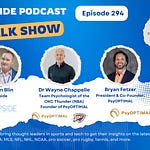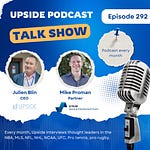This week we have the honor to interview a group of rehab and performance experts across the NFL and F1. We discussed neck training, their approach to neck training, the various modalities, best practices and trends that they are seeing in the market.
Pieter Bulsink, the CEO of Maverick Training, a sports performance company focused on elite athletes in F1 and other sports. Pieter has worked with F1 drivers such as Max Verstappen at Red bull (F1).
Kim Brouzes, an experienced Canadian sports therapist and CEO of Kinmetrix which built an advanced neck strengthening device collecting data.
Ryan Juarez, the director of rehabilitation at the Commanders, an NFL team.
📝Show Notes: Through this interview, we touched on neck training related topics especially:
Why neck training has become a priority in your sport, and how their approach evolved over the past 5–10 years.
How they assess neck strength and function in their athletes and if there are specific tools or protocols they rely on.
What a typical neck training program looks like during the offseason vs. in-season for your athletes.
If they have seen correlations between neck strength and reduced concussion or whiplash incidents.
What innovative technologies or techniques are making an impact in neck training right now.
What advice they would give to programs with limited resources who still want to prioritize neck health and performance.
You can read the full transcript of the podcast interview located at the top of this blog post.
Here are some of the best quotes of our conversation with Pieter, Kim and Ryan:
1. Why has neck training become a priority in your sport, and how has your approach evolved over the past 5–10 years?
Pieter Bulsink (F1):
“In motorsports, especially Formula One, everything starts at 300 kilometers an hour, and the G-forces on the neck are brutal. But what's often overlooked is the cognitive load that comes with it. When the neck fatigues, the entire sensory feedback loop—vision, vestibular input, motor coordination—begins to break down. That’s why our approach has evolved from just building neck strength to building strategic overcapacity. We don’t just want a strong neck—we want an unbreakable foundation for visual processing and cognitive function, especially under fatigue.”
Ryan Juarez (NFL):
“In American football, concussions have always been a concern, but about 10 to 15 years ago, awareness really exploded. Since then, everything has changed—from prevention to rehab, to return-to-play protocols. The evolution has been dramatic. Neck training used to be kind of generic—just another part of the strength program. But now it’s much more personalized and targeted. When I was in college football, we had a season with over 20 concussions. It became a crisis. Strength coaches were asking, ‘What more can I do?’ That’s when we really started to focus on neck training as a key piece of the puzzle.”
Kim Brouzes (Kinmetrix):
“To this day, we still don’t have a normative data pool for neck strength in athletes. People ask me all the time, ‘What’s a strong neck?’ And I have to say, ‘I honestly don’t know.’ We used to assume the big football guys with massive necks were the strongest, but that’s not always true. You can’t just look at size and assume strength. As we collect more data on the rest of the body, it’s becoming more clear that we need to apply the same data-driven approach to the neck.”
2. How do you assess neck strength and function in your athletes? Are there specific tools or protocols you rely on?
Pieter Bulsink:
“We have a testing protocol for our F1 drivers where strength is just the starting point—but function is king. We measure isometric holds in all planes, assess rotational control, and evaluate fatigue resilience through stress testing. One of our key differentiators is what we call ‘cognitive coupling.’ We put athletes through visual cognitive drills while they’re under neck fatigue to see how mental performance holds up. That’s where we find the real difference in high-level performance.”
Ryan Juarez:
“In football, neck strength assessments are usually tied to our concussion baseline and orthopedic physical exams. But I’ll be honest—it’s mostly subjective. We use simple isometric strength tests, goniometers for range of motion, or a 0 to 5 scale for manual resistance. It’s not very precise, which is why we’re always on the lookout for more objective tools that can help us be proactive, not just reactive.”
Kim Brouzes:
“For years, neck assessments were completely subjective—just a practitioner using their hands and saying, ‘Yeah, that feels like a 4 out of 5.’ Now with technologies like the Kinmetrix Arc device, we can finally collect objective data. We can assess strength isometrically and isokinetically through the full range of motion, and that opens the door for tracking progress, comparing athletes, and tailoring rehab or performance plans in a much more meaningful way.”
3. What does a typical neck training program look like during the offseason vs. in-season for your athletes?
Ryan Juarez:
“Right now we’re in our offseason, and our players lift four times a week—two upper body, two lower body. Neck training is built into the upper body sessions. Once we’re in-season, the load drops. Players are required to lift at least once a week, sometimes twice depending on the individual. We use four-way neck machines, manual resistance, bands, and sometimes med balls with rotational patterns. At one college I was at, we went from 21 concussions in one season down significantly after adding manual resistance neck work. The guys bought into it.”
Pieter Bulsink:
“Our F1 drivers travel constantly, so in the offseason we focus on building capacity through max strength, isometrics, resistance training, and fatigue protocols—especially emphasizing rotation, which is key for performance. We train 2–3 times a week using progressive overload. In-season, it’s all about maintenance and neuromuscular readiness. We microdose—short bursts, high intent, low volume—to keep them sharp without overloading them.”
Kim Brouzes:
“In-season training is all about maintenance. You don’t want to create tissue damage or inflammation that could compromise performance. The real adaptations—strength, resilience, tissue changes—happen in the offseason. That’s when you load and build.”
4. Have you seen any correlations between neck strength and reduced concussion or whiplash incidents?
Pieter Bulsink:
“We had one driver who crashed hard—into the tire wall, then spun into a concrete wall. Even with safety gear like the HANS device, it was a brutal hit. But he recovered incredibly fast, and I believe that was because of his neck strength. It's anecdotal, but it was very clear that his neck helped reduce the long-term effects.”
Ryan Juarez:
“In college football, I’ve seen seasons with 20 concussions drop dramatically the next year when we added more targeted neck training. It’s hard to say definitively that neck strength alone was responsible, but I believe it played a huge role. The guys who lift consistently and take their training seriously seem to recover faster from concussions, too.”
Kim Brouzes:
“Some studies suggest every pound of neck strength reduces concussion risk by about 5%, and increased extension strength can reduce concussion severity by 13%. But the quality of the research varies because the tools used were inconsistent—devices made in garages, tubing, etc. We need more standardized, accurate testing to really validate those findings. That said, the logic holds: a stronger neck means more control and less violent movement of the head during impact.”
5. What innovative technologies or techniques are making an impact in neck training right now?
Pieter Bulsink:
“For us, the game-changer has been integrating cognitive fatigue into our neck training. Our drivers don’t need balance—they’re strapped into a seat—but they do need razor-sharp focus under pressure. When cognitive fatigue sets in, motor control slows down. If your neck can’t stabilize that properly, everything else falls apart. That’s why we’re starting to explore connections between cognitive fatigue and concussion risk—it’s going to be a huge area of development.”
Kim Brouzes:
“At Kinmetrix, we’ve developed a device called the ARC that allows us to test neck strength isometrically and isokinetically through a full 72-degree range. Early in-house testing is showing improvements in spatial awareness, cervicogenic headaches, and reduced neck pain. But we’re not here to replace existing tools like Iron Neck or TopSpin 360—we’re here to complement them and provide the data to validate what’s working.”
6. What advice would you give to programs with limited resources who still want to prioritize neck health and performance?
Pieter Bulsink:
“Start simple, but don’t wing it. Use isometric holds in every direction—partner drills, resistance bands, towels, even neck harnesses if you have them. Most importantly, be consistent. Focus on endurance and movement control, not just brute strength. You don’t need fancy tools to build a smart, strategic neck training program.”
Ryan Juarez:
“The most important thing is just to start. There’s a lot of gear out there—from high-end devices to simple bands. You don’t need all of it. Focus on workflow. Athletes are busy—so find something that fits into their routine without adding friction. Efficiency is everything.”
Kim Brouzes:
“Understand the difference between harm and hurt. A lot of people don’t train their necks, so when they do, the soreness can scare them off. But that’s normal—just like training legs or shoulders. Be consistent, educate your athletes, and use simple tools like bands, towels, and manual resistance. That’s how we did it for decades, and it still works.”
You may also like:
🎙️ Upside Chat with Pieter Bulsink, CEO, Maverick Training, a Leading Sports Performance Company in F1 and Other Sports.
Today we have the honor of interviewing Pieter Bulsink, CEO of Maverick Training, a sports performance company focused on elite athletes in F1 and other sports.
⭐Upside Chat with Kim Brouzes, CEO of Kinmetrix, a Company that Built a Neck Strengthening Machine that Collects Data.
Today we have the honor of interviewing Kim Brouzes, CEO of Kinmetrix, a company that built a neck strengthening machine called the Kinmetrix Arc which collects data.
🔥Upside NFL Group Chat with Ted Rath (New Orleans Saints), Roderick Moore Jr (Pittsburgh Steelers), Ryan Juarez (Washington Commanders)
This week we have the honor to interview a group of NFL sports performance executives to talk about the latest trends in the world of sports performance, load management, sleep/recovery management, rehabilitation and data & wearable tech integration, and mental performance in the NFL.




